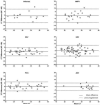Concordance between RT-PCR-based detection of respiratory viruses from nasal swabs collected for viral testing and nasopharyngeal swabs collected for bacterial testing
- PMID: 24875136
- PMCID: PMC4055503
- DOI: 10.1016/j.jcv.2014.04.011
Concordance between RT-PCR-based detection of respiratory viruses from nasal swabs collected for viral testing and nasopharyngeal swabs collected for bacterial testing
Abstract
Background: Epidemiologic studies of respiratory infections frequently rely on separate sample collections for the detection of bacteria and viruses. The requirement for two specimens presents cost, logistical, and acceptability challenges.
Objectives: To determine the agreement in detection of respiratory viruses using RT-PCR between two different types of samples collected on the same day: nasal swabs preserved in viral transport medium (NS) and nasopharyngeal swabs preserved in skim milk-tryptone-glucose-glycerol [STGG] medium (NP), the current standard for pneumococcal colonization studies.
Study design: Paired NS and NP samples were collected between May 2009 and September 2011 as part of the RESPIRA-PERU study, a large prospective cohort of Andean children <3 years of age. NS samples used polyester swabs and viral transport medium whereas NP samples used rayon wire-handled swabs and STGG medium. Samples were tested for influenza, human metapneumovirus (MPV), respiratory syncytial virus (RSV), human rhinovirus (HRV), parainfluenza virus 3 (PIV3) and adenovirus (ADV) using real-time RT-PCR. We calculated the agreement, and compared cycle thresholds (CT) between NP and NS samples.
Results: Among 226 paired NP-NS samples, we observed very high agreement with a Kappa statistic ranging from 0.71 for ADV to 0.97 for MPV. CT values were similar for both strategies.
Conclusions: NP samples preserved in STGG provide a simple and reliable strategy for identification of both pneumococcus and respiratory viruses. This single specimen collection strategy could be used for epidemiologic studies, especially in resource-limited settings. Furthermore, archived NP-STGG specimens from previous studies could be reliably tested by RT-PCR for viruses.
Keywords: Children; Epidemiology; Nasal swab; Nasopharyngeal swab; Respiratory virus.
Copyright © 2014 Elsevier B.V. All rights reserved.
Figures

Similar articles
-
Concordance in RT-PCR detection of SARS-CoV-2 between samples preserved in viral and bacterial transport medium.J Virol Methods. 2022 Jun;304:114522. doi: 10.1016/j.jviromet.2022.114522. Epub 2022 Mar 9. J Virol Methods. 2022. PMID: 35278534 Free PMC article.
-
Anterior nasal swabs compared to nasopharyngeal swabs for detection of respiratory viruses in children.Diagn Microbiol Infect Dis. 2025 Jul;112(3):116821. doi: 10.1016/j.diagmicrobio.2025.116821. Epub 2025 Mar 20. Diagn Microbiol Infect Dis. 2025. PMID: 40153904
-
Detection of respiratory viruses by PCR assay of nasopharyngeal swabs stored in skim milk-tryptone-glucose-glycerol transport medium.J Clin Microbiol. 2011 Jun;49(6):2311-3. doi: 10.1128/JCM.00224-11. Epub 2011 Mar 30. J Clin Microbiol. 2011. PMID: 21450959 Free PMC article.
-
Underascertainment of Respiratory Syncytial Virus Infection in Adults Due to Diagnostic Testing Limitations: A Systematic Literature Review and Meta-analysis.J Infect Dis. 2023 Jul 14;228(2):173-184. doi: 10.1093/infdis/jiad012. J Infect Dis. 2023. PMID: 36661222 Free PMC article.
-
Pediatric Respiratory Syncytial Virus Diagnostic Testing Performance: A Systematic Review and Meta-analysis.J Infect Dis. 2023 Nov 28;228(11):1516-1527. doi: 10.1093/infdis/jiad185. J Infect Dis. 2023. PMID: 37285396 Free PMC article.
Cited by
-
Suspension microarray-based comparison of oropharyngeal swab and bronchoalveolar lavage fluid for pathogen identification in young children hospitalized with respiratory tract infection.BMC Infect Dis. 2020 Feb 22;20(1):168. doi: 10.1186/s12879-020-4900-8. BMC Infect Dis. 2020. PMID: 32087697 Free PMC article.
-
Co-occurrence of bacteria and viruses and serotype distribution of Streptococcus pneumoniae in the nasopharynx of Tanzanian children below 2 years of age following introduction of the PCV13.Front Public Health. 2024 Jan 22;12:1298222. doi: 10.3389/fpubh.2024.1298222. eCollection 2024. Front Public Health. 2024. PMID: 38317802 Free PMC article.
-
Streptococcus pneumoniae nasal carriage patterns with and without common respiratory virus detections in households in Seattle, WA, USA before and during the COVID-19 pandemic.Front Pediatr. 2023 Jul 7;11:1198278. doi: 10.3389/fped.2023.1198278. eCollection 2023. Front Pediatr. 2023. PMID: 37484765 Free PMC article.
-
Respiratory Viral Detections During Symptomatic and Asymptomatic Periods in Young Andean Children.Pediatr Infect Dis J. 2015 Oct;34(10):1074-80. doi: 10.1097/INF.0000000000000812. Pediatr Infect Dis J. 2015. PMID: 26121205 Free PMC article.
-
Update on Human Rhinovirus and Coronavirus Infections.Semin Respir Crit Care Med. 2016 Aug;37(4):555-71. doi: 10.1055/s-0036-1584797. Epub 2016 Aug 3. Semin Respir Crit Care Med. 2016. PMID: 27486736 Free PMC article. Review.
References
-
- O’Brien KL, Nohynek H. Report from a WHO working group: standard method for detecting upper respiratory carriage of Streptococcus pneumoniae. Pediatr Infect Dis J. 2003;22:133–40. - PubMed
-
- Satzke C, Turner P, Virolainen-Julkunen A, Adrian PV, Antonio M, Hare KM, et al. Standard method for detecting upper respiratory carriage of Streptococcus pneumoniae: Updated recommendations from the World Health Organization Pneumococcal Carriage Working Group. Vaccine. 2013;32:165–79. - PubMed
-
- Griffin MR, Walker FJ, Iwane MK, Weinberg GA, Staat MA, Erdman DD. Epidemiology of respiratory infections in young children: insights from the new vaccine surveillance network. PediatrInfectDisJ. 2004;23:S188–S92. - PubMed
-
- Poehling KA, Edwards KM, Weinberg GA, Szilagyi P, Staat MA, Iwane MK, et al. The underrecognized burden of influenza in young children. The New England journal of medicine. 2006;355:31–40. - PubMed
Publication types
MeSH terms
Grants and funding
LinkOut - more resources
Full Text Sources
Other Literature Sources
Miscellaneous

